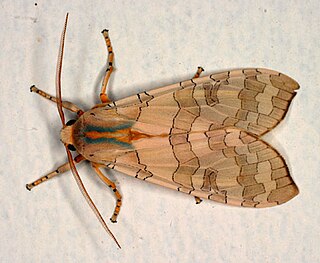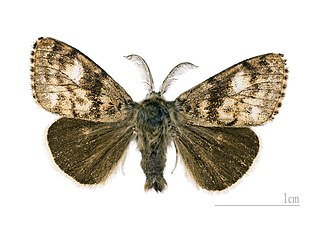
Lepidoptera is an order of insects that includes butterflies and moths. About 180,000 species of the Lepidoptera are described, in 126 families and 46 superfamilies, 10 per cent of the total described species of living organisms. It is one of the most widespread and widely recognizable insect orders in the world. The Lepidoptera show many variations of the basic body structure that have evolved to gain advantages in lifestyle and distribution. Recent estimates suggest the order may have more species than earlier thought, and is among the four most speciose orders, along with the Hymenoptera, Diptera, and Coleoptera.

The Noctuidae, commonly known as owlet moths, cutworms or armyworms, are the most controversial family in the superfamily Noctuoidea because many of the clades are constantly changing, along with the other families of the Noctuoidea. It was considered the largest family in Lepidoptera for a long time, but after regrouping Lymantriinae, Catocalinae and Calpinae within the family Erebidae, the latter holds this title now. Currently, Noctuidae is the second largest family in Noctuoidea, with about 1,089 genera and 11,772 species. However, this classification is still contingent, as more changes continue to appear between Noctuidae and Erebidae.

The Arctiinae are a large and diverse subfamily of moths, with around 11,000 species found all over the world, including 6,000 neotropical species. This group includes the groups commonly known as tiger moths, which usually have bright colours, footmen, which are usually much drabber, lichen moths, and wasp moths. Many species have "hairy" caterpillars that are popularly known as woolly bears or woolly worms. The scientific name of this subfamily refers to this hairiness. Some species within the Arctiinae have the word “tussock” in their common name due to people misidentifying them as members of the Lymantriinae based on the characteristics of the larvae.

The Pyralidae, commonly called pyralid moths, snout moths or grass moths, are a family of Lepidoptera in the ditrysian superfamily Pyraloidea. In many classifications, the grass moths (Crambidae) are included in the Pyralidae as a subfamily, making the combined group one of the largest families in the Lepidoptera. The latest review by Eugene G. Munroe & Solis, in Kristensen (1999) retains the Crambidae as a full family of Pyraloidea.

The Ditrysia are a natural group or clade of insects in the lepidopteran order containing both butterflies and moths. They are so named because the female has two distinct sexual openings: one for mating, and the other for laying eggs.
Sir George Francis Hampson, 10th Baronet was a British entomologist.

Arthur Gardiner Butler was an English entomologist, arachnologist and ornithologist. He worked at the British Museum working on the taxonomy of birds, insects, and spiders.

The Arctiini are a tribe of tiger moths in the family Erebidae.

Amphiesmenoptera is an insect superorder, established by S. G. Kiriakoff, but often credited to Willi Hennig in his revision of insect taxonomy for two sister orders: Lepidoptera and Trichoptera (caddisflies). In 2017, a third fossil order was added to the group, the Tarachoptera.

Glossata is the suborder of the insect order Lepidoptera that contains most lepidopteran species and includes all the superfamilies of moths and butterflies that have a coilable proboscis..

The Phaegopterina are a subtribe of tiger moths in the Arctiini tribe, which is a part of the family Erebidae.
Myoglossata is a clade within suborder Glossata within order Lepidoptera, the butterflies and moths. It contains the family Neopseustidae and the clade Neolepidoptera. Myoglossata is considered a clade, that is, a group of organisms made up of a single common ancestor and all of its descendants. They are distinguished by "intrinsic mouthparts". These added intrinsic galeal muscles are unique to the Myoglossata and developed after the galeae changed to form sucking parts.
Pseudapistosia is a genus of arctiine tussock moths in the family Erebidae.
The Global Lepidoptera Names Index (LepIndex) is a searchable database maintained by the Department of Entomology at the Natural History Museum, London.
Alexey Diakonoff full name Alexey Nikolaievich Diakonoff was a Russian entomologist who specialised in Microlepidoptera.
Józef Razowski, is a Polish entomologist and lepidopterist specializing in Tortricidae.
Pseudapistosia similis is a moth in the family Erebidae. It was described by George Hampson in 1901. It is found in Bolivia.

Eulepidoptera is a division of lepidopterans in the infraorder Heteroneura.












